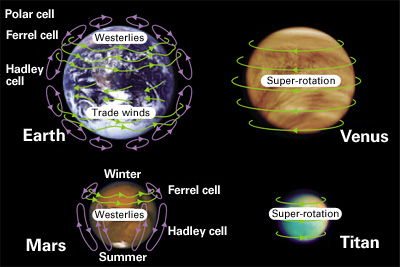TOP > Report & Column > The Forefront of Space Science > 2007 > Wind on Earth, Wind on Venus
![]()

Ancient ocean Nevertheless, many researchers believe that a great amount of water must have been present on Venus 4.6 billion years ago when the solar system formed. The disappearing-ocean scenario goes like this: water turns to vapor and is transported to the upper atmosphere, where it is broken down to hydrogen and oxygen by ultraviolet rays. Eventually, the light hydrogen escaped from Venusian gravity to outer space. One big question, however, remains unsolved – where and how did the oxygen contained in water disappear? A new answer to this question was recently proposed by George Hashimoto, Kobe University. Since the amount of oxygen was originally little in ancient Venus’s atmosphere (i.e., it was reductive), once the hydrogen was lost, the composition of the atmosphere must be the same as the current one. It is interesting to consider whether water existed in the form of ocean or as vapor in the atmosphere of ancient Venus. It has been theorized that, once the solar energy absorbed by a planet exceeds a certain level, all seawater on the planet would evaporate to form a thick vapor atmosphere (runaway greenhouse effect). According to some computation modeling, if the cloud effect is ignored, ocean barely existed on Venus for some time after its birth. If there were clouds, the sunlight would be reflected and the temperature must fall. In this case, the possibility of the existence of ocean increases. Considering that Mars preserves a number of features showing the existence of water currents, it may be common that planets once had ocean at some time in the past. “How did the winds blow, how did the clouds cover the planet, and until when did the ocean exist on ancient Venus,” all these questions are closely linked to the conditions for ocean to exist on planets. Super-rotation To study Venus’s paleoclimate or climate formation, such as the mechanism by which clouds cover the entire planet, it is important to know how the atmosphere circulates on the planet. In the study, we face a mysterious wind called the “super-rotation.” Venus rotates from east to west, contrary to earth. Its rotation period is 243 earthdays and rotation speed at its equator is 1.6m/s. Judging from traditional meteorology, wind blowing on such a slowly rotating planet was thought to be as slow as its rotation. However, this belief was reversed by observations of Venusian wind by the U.S. Mariner 10 explorer in 1974. Venusian wind blows in the direction of its rotation at a tremendously high speed, which reaches 100m/s at the cloud level, or 60 times the rotation speed, and circles the whole planet in about four days (Fig. 1). It is said that super-rotation was discovered before by an amateur astronomer in France. It had been ignored for a long time, however, in disbelief that such a wind could blow on Venus. 
New ideas on the causes of super-rotation are now being proposed by Japanese researchers including Masahiro Takagi, University of Tokyo, and Masaru Yamamoto, Kyushu University, and these are provoking research interest. Their theories are basically that rotational energy is conveyed from the ground to low-altitude atmosphere by the effect of large-scale fluid waves or circulations. The energy is further passed to the upper atmosphere to generate acceleration in the direction of rotation. Reproduction of super-rotation by computer simulation, however, is not so easy. Although the dynamic processes that might cause super-rotation are also present on earth, no clear explanation as to why super-rotation does not occur in the earth’s atmosphere has yet been provided. Thus, it is still unclear which factors separate earth-Mars-type and Venus-Titan-type winds. Which type of wind blows on the said terrestrial planet 20.5 light years away?
|
||||||




